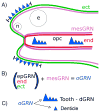The odontode explosion: the origin of tooth-like structures in vertebrates
- PMID: 20730948
- PMCID: PMC3034446
- DOI: 10.1002/bies.200900151
The odontode explosion: the origin of tooth-like structures in vertebrates
Abstract
Essentially we show recent data to shed new light on the thorny controversy of how teeth arose in evolution. Essentially we show (a) how teeth can form equally from any epithelium, be it endoderm, ectoderm or a combination of the two and (b) that the gene expression programs of oral versus pharyngeal teeth are remarkably similar. Classic theories suggest that (i) skin denticles evolved first and odontode-inductive surface ectoderm merged inside the oral cavity to form teeth (the 'outside-in' hypothesis) or that (ii) patterned odontodes evolved first from endoderm deep inside the pharyngeal cavity (the 'inside-out' hypothesis). We propose a new perspective that views odontodes as structures sharing a deep molecular homology, united by sets of co-expressed genes defining a competent thickened epithelium and a collaborative neural crest-derived ectomesenchyme. Simply put, odontodes develop 'inside and out', wherever and whenever these co-expressed gene sets signal to one another. Our perspective complements the classic theories and highlights an agenda for specific experimental manipulations in model and non-model organisms.
Figures



Similar articles
-
The homology of odontodes in gnathostomes: insights from Dlx gene expression in the dogfish, Scyliorhinus canicula.BMC Evol Biol. 2011 Oct 18;11:307. doi: 10.1186/1471-2148-11-307. BMC Evol Biol. 2011. PMID: 22008058 Free PMC article.
-
Evolutionary and developmental origins of the vertebrate dentition.J Anat. 2009 Apr;214(4):465-76. doi: 10.1111/j.1469-7580.2009.01053.x. J Anat. 2009. PMID: 19422425 Free PMC article. Review.
-
The conundrum of pharyngeal teeth origin: the role of germ layers, pouches, and gill slits.Biol Rev Camb Philos Soc. 2022 Feb;97(1):414-447. doi: 10.1111/brv.12805. Epub 2021 Oct 13. Biol Rev Camb Philos Soc. 2022. PMID: 34647411 Free PMC article. Review.
-
The ins and outs of the evolutionary origin of teeth.Evol Dev. 2016 Jan-Feb;18(1):19-30. doi: 10.1111/ede.12099. Epub 2014 Sep 15. Evol Dev. 2016. PMID: 25219878
-
Multiple epithelia are required to develop teeth deep inside the pharynx.Proc Natl Acad Sci U S A. 2020 May 26;117(21):11503-11512. doi: 10.1073/pnas.2000279117. Epub 2020 May 12. Proc Natl Acad Sci U S A. 2020. PMID: 32398375 Free PMC article.
Cited by
-
Developmental plasticity of epithelial stem cells in tooth and taste bud renewal.Proc Natl Acad Sci U S A. 2019 Sep 3;116(36):17858-17866. doi: 10.1073/pnas.1821202116. Epub 2019 Aug 19. Proc Natl Acad Sci U S A. 2019. PMID: 31427537 Free PMC article.
-
Redeployment of odontode gene regulatory network underlies dermal denticle formation and evolution in suckermouth armored catfish.Sci Rep. 2022 Apr 13;12(1):6172. doi: 10.1038/s41598-022-10222-y. Sci Rep. 2022. PMID: 35418659 Free PMC article.
-
Understanding the development of oral epithelial organs through single cell transcriptomic analysis.Development. 2022 Aug 15;149(16):dev200539. doi: 10.1242/dev.200539. Epub 2022 Aug 17. Development. 2022. PMID: 35831953 Free PMC article.
-
The homology of odontodes in gnathostomes: insights from Dlx gene expression in the dogfish, Scyliorhinus canicula.BMC Evol Biol. 2011 Oct 18;11:307. doi: 10.1186/1471-2148-11-307. BMC Evol Biol. 2011. PMID: 22008058 Free PMC article.
-
Mammalian enamel maturation: Crystallographic changes prior to tooth eruption.PLoS One. 2017 Feb 14;12(2):e0171424. doi: 10.1371/journal.pone.0171424. eCollection 2017. PLoS One. 2017. PMID: 28196135 Free PMC article.
References
-
- Reif W-E. Evolution of dermal skeleton and dentition in vertebrates: the odontode-regulation theory. Evol Biol. 1982;15:287–368.
-
- Miyake T, Vaglia JL, Taylor LH, Hall BK. Development of dermal denticles in skates (Chondrichthyes, Batoidea): patterning and cellular differentiation. J Morphol. 1999;241:61–81. - PubMed
-
- Nelson GJ. Pharyngeal denticles (placoid scales) of sharks, with notes on the dermal skeleton of vertebrates. American Museum Novitates. 1970;2415:1–26.
-
- Ørvig T. Phylogeny of tooth tissues: Evolution of some calcified tissues in early vertebrates. In: Miles AEW, editor. Structural and Chemical Organisation of Teeth. New York/London: Academic Press; 1967. pp. 45–110.
-
- Ørvig T. A survey of odontodes (‘dermal teeth’) from developmental, structural, functional and phyletic points of view. In: Mahala Andrews S, Miles RS, Walker AD, editors. Problems in vertebrate evolution. New York: Academic Press; 1977. pp. 53–75.
Publication types
MeSH terms
Grants and funding
LinkOut - more resources
Full Text Sources

